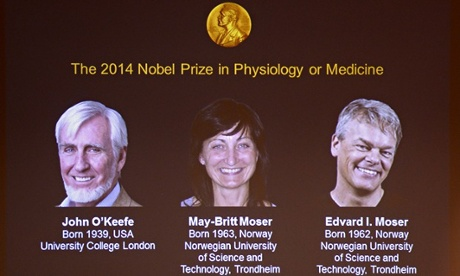Nobel Prize in Medicine
Awarded to Scientists for Discovering Brain's 'GPS'
The 1962 Nobel Prize
gold medal awarded to Dr. Francis Crick for his work in the discovery of the
structure of DNA will be offered by his family in a public auction conducted by
Heritage Auctions in New York City on April 10 with a portion of proceeds to benefit
scientific research at The Francis Crick Institute, scheduled to open in London
in 2015.
A trio of scientists
has been awarded this year's Nobel Prize in Physiology or Medicine for their
work related to nerve cells that create spatial maps in the brain to help us
navigate through our environments.
Half of the Nobel Prize
in Medicine goes to John O'Keefe, and the other half goes jointly to May-Britt
Moser and her husband Edvard I. Moser "for their discoveries of cells that
constitute a positioning system in the brain," according to an
announcement by the Nobel Foundation in Stockholm today (Oct. 6).
In 1971, O'Keefe
discovered the first component of the brain's "inner GPS" through
experiments in rats. He found that a nerve cell, called a place cell, in the
hippocampus became active when a rat was in a certain place, while other
"place" nerve cells turned on when the rodent moved to other places.
He realized these cells were building maps inside the brain's hippocampus of
various places in the rat's environment.
Then
in 2005, May-Britt Moser and Edvard I. Moser discovered so-called grid cells,
or a type of nerve cell that help generate a coordinating system for navigation
in a brain region near the hippocampus called the entorhinal cortex.
"Their
subsequent research showed how place and grid cells make it possible to
determine position and to navigate," according to a Nobel Foundation
statement.
More
recent work has found that place cells and grid cells are also in the human
brain, and they may be involved in some types of memory loss in people with
Alzheimer's disease.
O'Keefe, who was born in New York City, is currently the director of the Sainsbury Wellcome Center in Neural Circuits and Behavior at the University College London. The Mosers were both born in Norway. May-Britt is currently director of the Center for Neural Computation in Trondheim in Norway, while Edvard is the director of the Kavli Institute for Systems Neuroscience in Trondheim.
O'Keefe
will receive half of this year's Nobel Prize amount of 8 million Swedish Krona
(about $1.1 million), and the Mosers will share the other half of the money.
All three scientists awarded the prize
have dramatically changed how we understand the brain’s navigation and memory
systems. John O’Keefe made a remarkable discovery in 1971 when he found ‘place
cells’ in a brain region called the hippocampus, which provide an organised map
of space in their activity patterns.
O’Keefe speculated that place cells would
need information akin to latitude and longitude in order to map space. Where
this signal was located remained mysterious until 2005 when May-Britt and Edvard
Moser discovered ‘grid cells’ in a brain region known as the medial entorhinal
cortex. These cells show hexagonal patterns of activity stretching over the
space traversed, similar to the lines that mark out distances on a globe.
Grid cells and place cells offer one of
the few bridges neuroscientists have linking the cellular level to the
cognitive level, as they help explain how individual brain cells help us
navigate, remember the past and imagine the future. The IgNobel prizewinning
discovery that the hippocampus of London taxi drivers grows larger with
experience would have likely been missed without such fundamental discoveries

